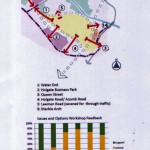The promised report on Labour plans for a new £10 million bridge near Wilton Rise has now been published.
It turns out that £1.5 million of this will be spent on consultant’s fees.
The report claims that the costs of the bridge would be repaid “from the additional income in Business Rates and Council Tax generated by the new developments” (on the York central site).
It then goes on to claim that 1083 new homes will be provided. That is a surprise because the draft Local Plan published by Labour in April assumed only 438 homes would be constructed on this site.
However, the housing numbers included in the Labour draft Local Plan have already been undermined with actual planning applications submitted, and approved, over the last 6 months being in every case higher than the Plan estimate
.
Therefore a much higher housing figure is a legitimate target for the York central site.
The present coalition government policy does encourage development and allows local authorities to retain and invest, for 6 years, additional Council Tax monies generated by new homes (New Homes Bonus).
Business Rates have also been “localised”. So an increase in income from additional commercial buildings would increase the amount that the Council receives from Business Rates. However government grants, which seek to equalise Council income between “prosperous” and less well off areas, could be reduced.
No business case of any sort has been provided for the meeting next week.
In addition to the homes, the “plan” talks about “building 93,000 sq m of office space with ancillary bar, restaurant, retail and leisure uses” in 2015.
A further 35,000 sq m would be built in 2019 in the form on a commercial area “in front of the station” and would include a new hotel although most would be more offices.
Of course, any incremental development in the City provides similar increases in Council income plus more jobs and homes.
Residents might have expected any income to be earmarked to pay for repairs to the public services in the City which have deteriorated so badly over the last 3 years.
Incredibly, the Council is being asked to earmark the £10 million without a development “Masterplan” being in place.
As a result no planning permission exists for the development.
The absence of a business plan is the major problem at present. It remains unclear how the site clean up will be funded (it is heavily polluted) nor is there any guarantee that other transport infrastructure needs can be financed.
From the information, that has been made available, it does seem that the Councils investment will not be underwritten in any way.
It is therefore a very high risk venture.
There is no proposal to form a joint development company which would allow Council Taxpayers to share in the success of any development (to offset the substantial risk)
The legal restrictions – which apply across Europe – on subsidising private companies are not explored in the paper.
Like the sale of the Haymarket car park on Hungate – for around 50% of its current open market value – the Council is being both naïve and reckless with taxpayers money. The promised offices and hotel on Hungate have yet to move forward and so have provided no economic stimulus for the City.
The “Bridge to Nowhere” could well be a similar embarrassment.


